In October 2011 I walked through the mid-Bronx from the Grand Concourse to Parkchester, east through Mount Hope, Tremont, Belmont, Bronx Park South and West Farms, pretty much the center of the Bronx, a land sadly not visited by FNY as much as it should be. I consider the borough sort of “interconference”, in football terms. In the NFL, there are teams in your division you play twice a year, teams in your conference you see fairly often, and teams out of conference you see every 4 years or so. This division roughly dates back to the days before the American and National Football Leagues merged in 1970. For me, Brooklyn, Manhattan below 125th Street and Queens –despite encompassing vast acreage — are “in conference” while northern Manhattan, Bronx and Staten Island are “out of conference.”
Anyway, I visit the Bronx more than every 4 years; it’s more like every 2 or 3 months, and the subconscious — or consciously imagined — horrors never seem to manifest themselves.
Getting off the D train at The Conk and East Tremont Avenue you are met with the Bronx’ answer to the Flatiron Building, a sliver-thin parallelogram defined by Concourse, Tremont, Monroe Avenue and Mount Hope Place. It’s one of the older apartment buildings on the Concourse, dating to 1914 (the year Bronx became a county). For awhile this was the tallest building in the borough. Tremont Avenue, the borough’s lengthiest, runs from the Harlem River to the East River in Throgs Neck and is named for three now-leveled hills in this neighborhood.
GOOGLE MAP: Concourse to Parkchester
Mount Hope Place runs from Jerome to Anthony Avenues south of East Tremont. According to Bronx historian John McNamara (the Venerable John) it runs atop a slight rise and has gone under a number of previous names. Perhaps it acquired the moniker because of high expectations regarding its development. The block between the Concourse and Anthony features some distinctive attached houses and old-style porched homes.
Though there are small areas in the Bronx given Landmarks designation, such as Clay Avenue in Morrisania, Mount Hope Place is still awaiting notice.
Shuttleworth Mansion
The Shuttleworth Mansion, at Anthony Avenue and Mount Hope Place, looks like one of those places cousins of Herman Munster might occupy. I provided a couple of photos from an earlier foray, since it is nearly invisible because of surrounding vegetation in warmer months.
In 1896 Edwin Shuttleworth was a stone dealer and approached the Neville & Bagge architectural firm with the idea of creating a house using one of the varieties of stone he sold. The architects embellished the plan by bringing in stone carvers who created ornate male and female forms, marine elements and picturesque busts.
This house has been given designation by the NYC Landmarks Preservation Commission.
East Tremont and Webster Avenues meet at O’Brien Square, where East Tremont has to angle around a high hill and rock outcropping, the site of O’Brien Square and Richman (formerly Echo) Park. This 1930s-era Art Deco building can be seen on the southeast corner.
Because of its topography, the Bronx can’t support a rigid street grid — Manhattan’s hills were largely leveled off and south of Central Park, it looks like a waffle iron except for the Broadway diagonal. Though a rough grid was placed on the Bronx, main streets sometimes waver or curve and, as a result, the Bronx is known for its curving apartment building facades. This one is at East 176th and Webster across from Richman Park.
Webster Hotel, on the east side of the road north of Tremont. Wel, it does hve a park view.
Webster Avenue is one of the Bronx’ longest streets, running continuously from Gillespie Square at Melrose Avenue and East 165th north to the Yonkers line, where it becomes Bronx River Road. The 3rd Avenue el once shrouded it between Fordham and Gun Hill Roads. And as you can see on the light pole, U.S. 1, which runs from Maine to Key West, Florida, assumes part of the avenue.
The park occupying a rocky outcropping at O’Brien Square, East Tremont and Webster Avenues, is officially known as Julius Richman Park, but with due respect to Richman (1915-1973) chairman of the Twin Parks Association and the Urban Action Task Force, and Assistant Administrator of the City’s Finance Committee, “Julius Richman Park” simply doesn’t carry the mojo of the park’s old name, Echo Park, so named because sound waves can ricochet and bounce off the rocks, incredible reminders of the Ice Age.
Passing Park Avenue
The roadway on either side of the Metro North tracks, formerly NY Central, is Park Avenue — a Bronx extension of the same Park Avenue lined with swanky apartment buildings and churches in Manhattan between Grand Central Station and East 96th Street. The original 4th/Park Avenue in Manhattan was home to at-grade steam belching railroads, as well, and its Bronx counterpart, with the tracks sunk in an open cut, has some, but not all, of the atmosphere of that 19th Century Park Avenue.
When the NY Central was extended uptown in the mid-1800s the road went by other names, including Vanderbilt Avenue after the founder of the NY Central, but the city settled on Park Avenue by 1896.
Crossing the railroad via a pedestrian bridge at East 178th, I found this apartment building I liked with wraparound windows at Washington Avenue. The brickwork departs from the usual Flemish bond.
St. Joseph’s Church on Bathgate Avenue between East Tremont and East 178th, is more massive than this somewhat narrow front suggests. The church, completed in 1899, extends all the way back to Washington Avenue a block west.
The Parish of St. Joseph was established in 1873 by Archbishop McCloskey to serve the German Catholics in Tremont and the surrounding areas. In October 1873, the cornerstone was laid for the first church, a handsome Gothic structure that fronted Washington Avenue near 177th Street (now Tremont Avenue). The completed church was dedicated on March 22, 1874. The first resident pastor was the Rev. Joseph M. Sorg, who remained until 1877.
Ground was broken for the present church in October 1898. Located near the original building, the new church was built on a lot that has a frontage of 108 feet on Bathgate Avenue and a depth of 105 feet, running through to Washington Avenue. The neo-Gothic church was built of white stone quarried from the lot, and faced with polished granite on the front and rear ends. When built, the church provided seating for about 1,500 persons. NYC Organs
This 1969 photo shows the nearby Third Avenue El in all its glory, with the considerably sootier St. Joseph’s in the background, with Crotona Park in the foreground.
St. Joseph’s grade school (1922) is directly across the street from the church.
The former 37th Precinct Police building, 1925 Bathgate, just south of St. Joseph’s, was later the 48th Precinct until the 1970s and now home to a Baptist church Head Start program. It was completed in 1901 and is a freestanding, three story rectangular block, seven bays wide. The facades are composed of yellow brick with stone trim in the Italian Renaissance Revival style.
The back edge of St. Barnabas Hospital (and the older buildings in the complex) at Quarry Road and Oaktree Place. The land for the institution was donated by the Lorillard family, of tobacco fame, who had large Bronx holdings in the 1800s.
[St. Barnabas] Hospital was founded [in 1866 as “The Home for the Incurables”] by the Reverend Washington Rodman, rector of Grace Episcopal Church, in the West Farms area of what is now the Bronx. He called together a group of public-spirited citizens to explore how to provide a haven for so-called incurables who could not be cared for in existing hospitals. Reverend Rodman’s goal was to bring hope and medical care to a group that had neither. St. Barnabas
Barnabas, one of the earliest prominent converts to Christianity, accompanied St. Paul on his many journeys throughout the Mideast in the 1st Century AD, spreading the gospel. His story appears in Acts of the Apostles.
Quarry Road runs diagonally across the street grid in Tremont from 3rd Avenue northeast to a maze of streets in Belmont where Arthur Avenue, Crescent Avenue and East 182nd and 183rd Streets meet. The quarry for which it is named was on the Lorillard grounds.
And at that maze of streets is D’Auria-Murphy Triangle; the park’s centerpiece is a statue of Christopher Columbus that was moved here in 1992 from P.S. 45 on Bathgate Avenue and Lorillard Place. It is the work of Attilio Piccirilli (1866-1945) whose world-renowned studios on 142nd Street and Willis Avenue produced the Maine Monument at Columbus Circle, completed in 1925, and the statue of Abraham Lincoln in the Lincoln Memorial.
This park gets its name from the D’Auria-Murphy American Legion Post in the Belmont section of the Bronx. The post was created in 1918, following World War I, and the members planned to name it for the Mayor of New York, John P. Mitchel (1879-1918), at an elaborate installation ceremony. When the mayor failed to appear, the Legionnaires changed the name at the last minute to honor two young men from the neighborhood who had lost their lives in the war, John D’Auria (1889-1918) and Henry J. Murphy (1891-1918). NYC Parks
Arthur Avenue
This street in the center of the Belmont neighborhood anchors what is now NYC’s most vital Little Italy. After other contenders for the crown like Mulberry Street in SoHo and Brooklyn’s Bensonhurst have slipped due to immigration from other countries, Belmont has continued to be the go-to location for Italian restaurants, bakeries, groceries, meat and fish shops and cultural activities.
Belmont (and the avenue of the same name that runs through it) was named for the mansion on the Lorillard estate; Arthur Avenue was named for President Chester Alan Arthur — a Lorillard, Catherine Lorillard Wolfe, was a fan of the mutton-chopped Republican President.
Pasquale’s Rigoletto Restaurant is named for the popular Giuseppe Verdi opera, based on a play by Victor Hugo.
The Randazzo’s Seafood retail shop apparently has nothing to do with the more famed Randazzo’s Clam Bar in Sheepshead Bay, Brooklyn.
Mayor Fiorello LaGuardia spear-headed one of the neighborhood’s most beloved attractions, the Arthur Avenue Retail Market – a kind of covered Italian bazaar that brings together under one roof all the shopping also found on nearby streets, from sausage makers to bread bakers, cafe’s to florists. The variety is truly staggering – all told some nine restaurants, five pastry shops, four butchers, two pasta-makers, six bread stores, three pork stores, five gourmet delicatessens, two fish markets, three gourmet coffee shops and one gourmet Italian wind shop – to list only the food category. And then there are the gift and houseware shops. Arthur Avenue Bronx
This was one of a number of retail markets set up by the LaGuardia Administration in the 1930s as a way of controlling the proliferation of pushcarts on the streets. There are others scattered around town, such as the 1st Avenue Retail Market in the East Village, the 13th Avenue Retail Market in Borough Park, Brooklyn and the Essex Street retail Market on the Lower East Side, likely the largest.
Biancardi’s, an old-style meat market with Italian specialties hanging in the window.
Biancardi’s is that throwback butcher shop that some home cooks dream about: a large, sparkling-clean, tile-covered shop filled to the brim with all things meat. Trimmed cuts of lamb, beef, pork and veal are arrayed alongside stacked rows of harder-to-find items like quail, rabbit and pheasant. And of course, as a shop indebted to southern Italy, Biancardi’s offers lots of coiled, freshly-ground sausages, yards of glittering honeycombs of tripe, house-cured pancetta, tubs of sweetbreads and brains, and even the occasional glaring goat’s head. New York Magazine
I was attracted to G. Addeo & Sons Bakery for the old hand-lettered sign. “Brooks of Sheffield” of Lost City was attracted to the second Addeo Bakery on Hughes Avenue, which also has an old school sign, for the wonders displayed in the window:
The Addeo Bakery is so ridiculously picturesque, it looks like a movie studio cooked it up. I don’t mean the one on Arthur Avenue, but the branch one block away on Hughes Avenue. It partly draws its stark pictorial loveliness from the fact that Hughes is largely unpopulated by shops. Addeo stands alone in Hopperesque glory on a lonely corner all its own. Your can gaze into the shop from two sides. Or just gaze at it from across the street, as I often do when I’m in the neighborhood.
The interior itself is classic and unspoiled. Ornate tile floor, shelves for bread, light fixtures, a scale or two and little else. Many loves of the bakery’s vaunted Pane di Casa—advertised in wonderfully homey, hand-painted signs outside—adorn the window displays. They are crusty and magnificent, and it is a challenge to pass by and not purchase one.
If Addeo is the measure, nearly every other store in New York is an eyesore.
Mural alongside a parking lot, “in loving memory.”
The Sacred Heart (also known as Most Sacred Heart of Jesus) is one of the most famous religious devotions to Jesus‘ physical heart as the representation of His divine love for Humanity.
This devotion is predominantly used in the Catholic Church and among some high-church Anglicans and Lutherans. The devotion especially emphasizes the unmitigated love, compassion, and long-suffering of the heart of Christ towards humanity. wikipedia
Umberto’s Clam House, which still operates in Little Italy, gained infamy in its incarnation there when mobster Joey Gallo was shot dead there in 1972:
Joey Gallo had celebrated his 43rd birthday at the Copacabana nightclub with a group of arty friends that included the actor Jerry Orbach, comedian David Steinberg, and columnist Earl Wilson. The party finished and Gallo, his bodyguard, and four women went to Little Italy in downtown Manhattan, looking for a place to eat. The only restaurant open was Umberto’s Clam House on Mulberry Street, owned by the mobbed up Matthew ‘Matty the Horse’ Ianniello. Robert Daley, Deputy Police Commissioner, said the party ate ‘Italian delicacies.’ Gallo and his bodyguard, Pete Diapoulis, sat with their backs to the door. The assassin (from the Colombo mob family) put four bullets into Crazy Joey Gallo at about 5 a.m. Gallo staggered out the front door onto Mulberry Street, where he collapsed and died. Twenty shots were fired in all. The assassin escaped. Pete Diapoulas was wounded. He refused to talk to the police. The shooting left ‘Little Italy’ (the surrounding neighborhood) in an agitated state. Witness said they saw pistols in tenement windows. Deputy Commissioner Robert Dailey said, ‘He made a mistake, Crazy Joe did. He should have gone home to bed last night.’ Museum Planet
Umberto’s, of course, is no longer in its original location on Mulberry Street. The “new” one is on Broome Street. When I was a kid, I had lunch with my mother in an Umberto’s branch at 86th Street and 16th Avenue in Bath Beach.
Also note that “Crazy Joe,” who is buried in Green-Wood Cemetery in Brooklyn, had a lot of showbiz friends. The line between fame and notoriety can occasionally be blurred, and what’s right and wrong can sometimes be ignored.
A classic Fiat was displayed on the sidewalk. Name that year!
In 2011 Fiat has been using Castle Hill native Jennifer Lopez as a spokeswoman, but a flap ensued when it turned out that Jenny From The Block filmed her commercial scenes in California and never returned to the Bronx, as depicted in the spots.
The whole neighborhood had turned out on a bright October 2011 day. Just a couple weeks later, there would be a freak snowstorm. On East 187th the Italian tricolor is displayed outside Borgatti’s pasta retailer.
The classic neon sign at Egidio Pastry, 187th and Hughes, says the store was established in 1912.
Topped by a gold-lettered awning, it is a fixture of Belmont, the Bronx’s own Little Italy, and like its sister cafes, it is loved for its inky espresso, its crisp-shelled cannoli and its comfortable conviviality.
The mistress of the house is Carmela Lucciola, a 53-year-old businesswoman with auburn hair who still looks good in a short skirt and knows it. With the holidays on the horizon, she is busier every day. Recently she could be overheard helping a pair of fashionably dressed grandmothers from the suburbs who had returned to the old neighborhood to order pastry platters for a baptism celebration. NY Times, 2004 (This 4-page article provides the complete history of the Egidio family and their pastry shop.)
Our Lady of Mt. Carmel Catholic Church, East 187th and Belmont, has been called the anchor of the neighborhood. The Italianate-style church was constructed in 1917, with the parish established 10 years before. Mount Carmel, in Israel, was a major place of veneration of Mary, the mother of Jesus, and the Carmelite Order of Brothers was established there in the 12th Century.
There was a time, between 1964 and 1984, when all new Bronx street signs were blue and white. Later, blue and white became the color of the signs for local heroes being honored by the Department of Transportation with a corner sign. (Later, even they turned green and white.) Usually, the identities of the persons so honored are mostly unknown to everyone but their families and friends, but I’m quite familiar with this one.
ForgottenFan Julian Stein:
| It is not the Department of Transportation that honors local heroes like Dion DiMucci with signs. The City Council passes a bill designating a location with a local person’s name, and the Mayor signs the bill into law. DOT just puts up the sign. |
Dion DiMucci was born in 1939 in Belmont; his father was a vaudevillian and so, Dion grew up around music. In the 1950s, street singing was how you got noticed and before long, he was booked in local clubs and made a few 45s. He was teamed with a local group called the Belmonts, after the avenue, and his career took off — his good looks were not a hindrance in his ascent to pop stardom. Between 1958 and 1968 he rang up a dozen Top 20s, with and without the Belmonts.
Dion at the height of his fame in 1962, when audiences were very well-behaved:
His career, and his life, nearly ended early. On February 2, 1959, Dion was on a Midwest package tour headlined by Buddy Holly and also featuring Richie Valens and Jiles Richardson (“The Big Bopper.”) Holly was tired of taking buses on the grueling tour in icy weather and so hired a single-engine plane that sat the pilot and three others. Dion balked at the fare, $36, the same amount his parents were paying for monthly rent in the Bronx, and his seat went to Valens. The plane crashed, killing all aboard. Dion’s career has continued for over 50 years.
This is a 2004 performance of his first hit, “I Wonder Why”:
ABOVE: Crescent and Cambreleng Avenues; below: Crescent and Belmont Avenues.
Crescent Avenue, like Quarry Road, cuts diagonally across Belmont’s street grid, creating interesting angles and vistas. The avenue originally marked the southern border of a couple of farm properties.
The Notre Dame Apartments, 660 East 183rd at Cambreleng, must have an ecclesiastical connection of some sort. Crosses and a saint giving a blessing are on the building’s pediment. An aerial shot shows a church nave.
The answer is that this used to be the Bronx locale of the Little Sisters of the Poor organization.
PS 32, the Belmont School, East 183rd between Cambreleng and Beaumont, is a K-5 public school, known locally as the “Castle of Learning.” Would like to know more about PS 32 and its gargoyles, but most NYC public school websites are tight-lipped about the building’s history, concentrating on what’s going on within in the present day.
Grote Street gently curves against the Belmont street grid. Along with Third Avenue, East 182nd and 184th Streets, it traces the old route of East Kingsbridge Road, which today reaches its eastern end at Fordham Road. Perusing maps as a kid, I thought it had something to do with Mets catching great Jerry Grote (which is pronounced “groaty,” the Bronx street is pronounced “groat” without the “e.”) Frederick Grote was a local 19th Century musician. There is a Seaver Avenue in Staten Island that, similarly, has nothing to do with Tom Seaver.
St. Thomas Aquinas High School, Grote between Belmont and Cambreleng. The all-girls high school was originally established in 1900 as St. Martin’s Academy and only served Grades 1-6. In 1923, Aquinas Hall opened as a two-year business school. The school established a 4-year high school in 1934. Longtime All My Children TV actress Debi Morgan is an alumna.
St. Martin of Tours Church, Grote Street and East 182nd. The present church building was completed in 1952; the parish was established in 1897 and a nearby apartment building bears its name.
The church was forced to close its elementary school in 2011. Schools like St. Martin’s were community bulwarks throughout the evil years of the 1960s-1980s, when southern Bronx was a drug gang war zone. And now, they are going away. Alumnus David Gonzalez wrote a moving article in the NY Times in which he remembers:
This school has long been a sanctuary amid uncertainty — as it was for me starting in 1964, when my parents fled Hunts Point for the safety of Crotona. The fires followed a few years later, and we moved away in 1969. But I still took two buses from Morris Heights — past blocks reduced to rubble — until I graduated.
Forget the cheap jokes about ruler-swinging nuns gliding through the aisles in full-length habits. For those of us who saw our neighborhood almost vanish in smoke from arson or crack pipes, Sister Nora stands as a reminder of the sacrifices made happily and gifts given freely by women religious. Through word and deed they taught us the works of mercy: to feed the poor, clothe the naked and educate the ignorant.
To comfort the afflicted.
And now — 40 years after I walked down the aisle clutching my diploma — I returned to fulfill a final work of mercy: to bury the dead. NY Times
Crotona Parkway, a corridor-like extension of Crotona Park, runs on the east side of Southern Boulevard from Boston Road north to the SW edge of Bronx park at the zoo. It was opened in 1910. Crotona Parkway, Crotona Park and Crotona Avenue and the aqueduct all take their names from Croton, a region in southern Italy where athletes trained for the ancient Olympic Games.
The Beck Memorial Church, East 180th Street and Vyse Avenue. The church building, dedicated in 1895, was built by Charles Bathgate Beck in memory of his late mother Janet B. Beck. The congregation, the First Presbyterian Church in the Village of West Farms, was established in 1814.
We are entering the neighborhood of West Farms, which at one time was a separate Bronx village after its separation from Westchester County in 1846. It was annexed to New York City, along with the rest of the Bronx west of the Bronx River (the towns of Morrisania and Kingsbridge), in 1873, with the rest of the Bronx joining Greater New York in 1895. Bronx became a borough in 1898 and a county in 1914.
The Old West Farms Cemetery, East 180th between Vyse Avenue and Boston Road, was established in 1814 with veterans of the War of 1812, Civil, Spanish-American and World War I interred here. The grounds are in better shape when I first encountered them in 1998: they were announced by a splintering wood sign and there was no protective fence.
I have always had a soft spot for the Lambert Houses at East 180th and Boston Road — built in 1973, they have a unique design among public housing projects.
Countering the argument that low-rise housing underutilizes valuable land, the six-story Lambert Houses buildings were designed by the architectural firm of Davis, Brody and Associates to make public housing more livable. The design, which received an award from the New York Society of Architects, includes five clusters of buildings with parking space, a commercial area and a community center. NY Times
Had I wanted to go back to Flushing from here, I could: this is the last stop of the Q44, which runs to Jamaica, Queens; instead I pressed on past a waterfall.
The Bronx River, which for a few decades in the 1800s was the city line, is the only true river located totally in NYC, arising in upstate highlands and flowing south into the East River. The Hudson, you say? Part of it is in New Jersey. A Bronx River waterfall is in view of East 180th. As you might suspect, the waterfalls in the Bronx River within the city limits are all man-made dams, which doesn’t detract from their attractiveness.
This is the southern edge of 720-acre Bronx Park, which contains both the Bronx Zoo and the NY Botanical gardens.
Bronx Central Office, Fire Alarm Telegraph Bureau, East 180th and Devoe Avenue. The Italian Renaissance building is newer than you would think: built 1923.
East 180th is here passed over by three consecutive elevated structures: the White Plains Road elevated line serving both the #2 and #5 IRT trains…
…a trestle belonging to the old NY, Westchester and Boston Railroad, which opened in 1912 and was originally going to be a connector all the way to New England. It was never completed and in the 1930s the Westchester tracks shut down for good. n 1940, the Bronx tracks were annexed to the IRT at East 180th and became the Dyre Avenue line, first as a shuttle, then connected with trackwork to the White Plains line.
…and finally by an elevated section of the Bronx River Parkway, the first modern, multi-lane limited-access parkway in North America, built in sections from 1917-1952. Buses can run on the southern NYC section.
What is possibly the grandest NYC subway station house is here on Morris Park Avenue near East 180th. The building, thankfully protected by landmark, was constructed in 1912 as a grand Italian villa station for the New York, Westchester and Boston Railroad that operated between the Bronx and Westchester from 1912 to 1937 (it never made it to Boston) and was subsequently sold to NYC and became the Dyre Avenue Line. Other station houses along the line have survived too. Mercury, the Roman messenger god, was the designated symbol of the line.
Young Park, at the triangle at East Tremont and East 180th, was named for a local World War I hero in 1933.
James Young was designated as Chief Gunners Mate on a naval boat, which and was assigned to thwart attacks by German U-Boats. By 1917, the U-boats were sinking nearly 875,000 tons of British supplies every month, a pace which would have forced the British to surrender by the end of the year. The combined British and American naval forces were able to inflict a great deal of damage on the German submarines through the use of destroyers and hydroplane bombers. After several months at sea, Young was killed in action on October 30, 1917. NYC Parks
We’ve seen Him before. Mural at an auto repair shop on East Tremont near its railroad overpass.
At the repair shop sat a 1961 Chevy Corvair. The model has been named by Time Magazine as one of the worst 100 makes of all time.
The railroad tracks here are used mainly by Amtrak trains out of Penn Station via the Hell Gate Bridge bound for New England or points west.
The walk began at Tremont Avenue and here it is again. It’s the longest east-west street in The Bronx, running from the Harlem River east and southeast to the East River at Throg(g)s Neck. It was assembled over the decades from shorter roads merged together under one name. Like Boston’s Tremont Street, it is named for three now-leveled hills.
Along the railroad Tremont Avenue features mainly industry, gas stations and auto repair shops. This one specializes in taillights.
There are not many chances here to cross the open-cut Amtrak railroad. Two are afforded by these twin truss bridges on White Plains Road and Unionport Road.
Parkchester, a large apartment complex (large enough to comprise an entire neighborhood) in the mid-Bronx, is bounded by White Plains Road, East Tremont Avenue, McGraw Avenue and (part of the way) by Castle Hill Avenue. The complex was built in 1941 by the Metropolitan Life Insurance Company on 110 acres, some of which had been occupied by the New York Catholic Protectorate, a home for poor children. For its time, Parkchester was a pioneer in rental-unit engineering, as it included amenities like gleaming new bathrooms with non-slip bathtub bottoms, double sinks and cabinets in the kitchens — an innovation at the time. The complex boasted a bowling alley, recreation areas, the very first Macy’s branch outlet, and three movie theatres in or near it: The Loew’s American (still there as a multiplex), the Palace and the Circle.
Met Life provided Parkchester with a rather whimsical style. While the tall seven and twelve-story buildings appear somewhat monolithic when viewed from afar, a walk around the complex reveals the friendly face Parkchester presents: its generous employment of colorful, playful terra-cotta statues and sculpture by renowned sculptor Joseph Kiselewski, executed by the Federal Seaboard Terra Cotta Corporation. Included is the bare breasted lyre plucker seen here.
Heading south on White Plains Road. While generally residential in the Parkchester area, there are also some flat-fix shops with generous displays of rubber.
Where White Plains Road meets the Cross Bronx Expressway, you encounter Virginia Park, which opened in 1956 and was named for a nearby avenue. This is about as old-school as NYC public parks get — old style splintering benches arrayed around vast plots of concrete, London plane sycamore trees. May it never change.
Before climbing on the Q44, which runs past here, too, I got some photos of Hugh Grant Circle at the confluence of Westchester and Metropolitan Avenues and the Cross Bronx Expressway. It is named for the youngest mayor in NYC history, not the cheeky British actor.
Photographed October 2011; page completed 1/2/12









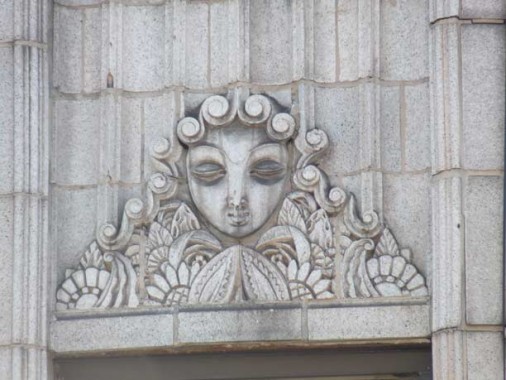




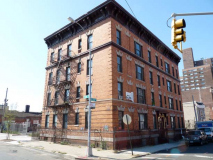
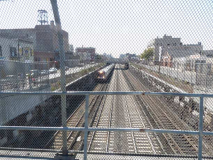


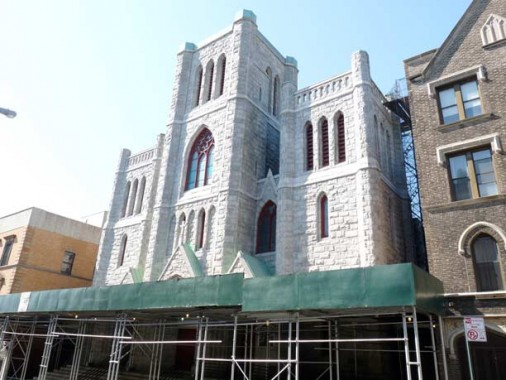


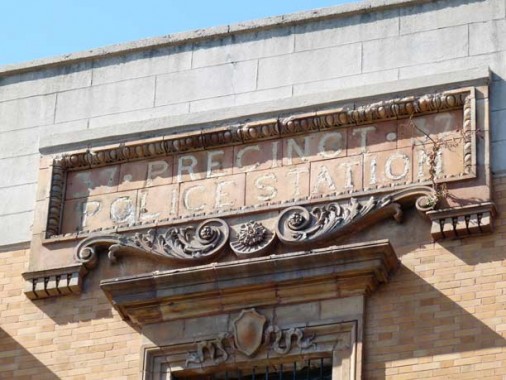











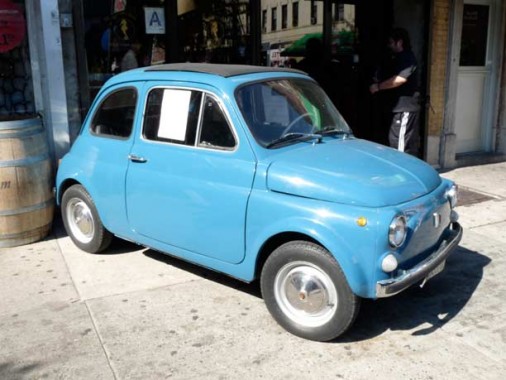


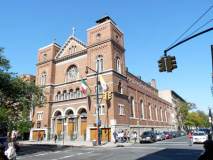
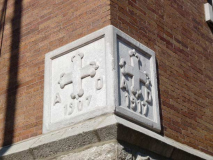







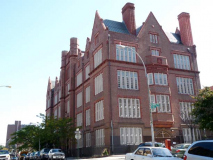
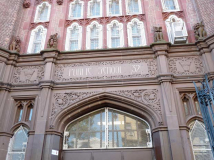
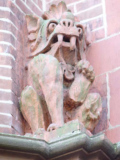

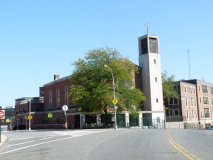
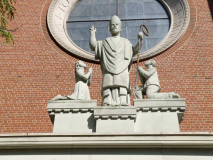
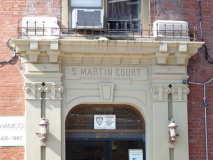




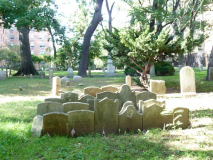

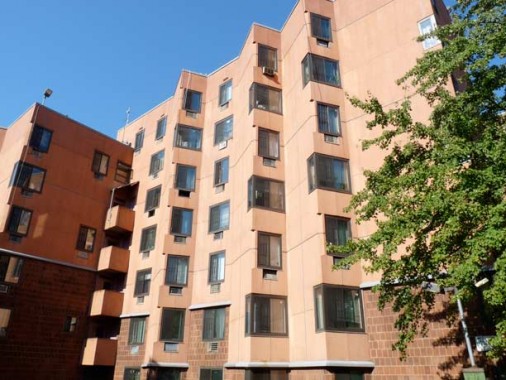
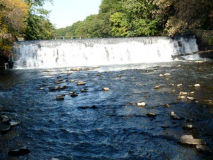

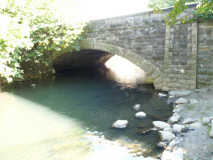
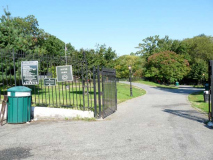
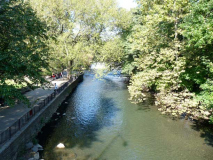
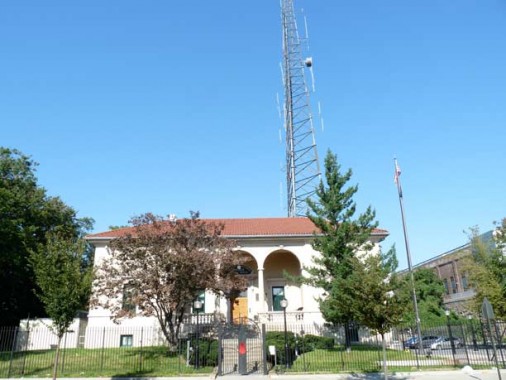




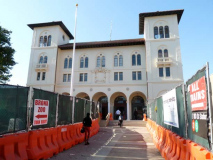
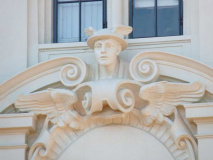
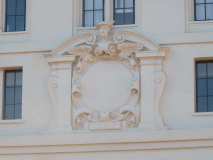



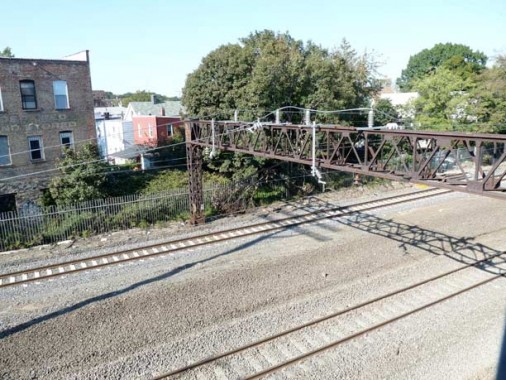





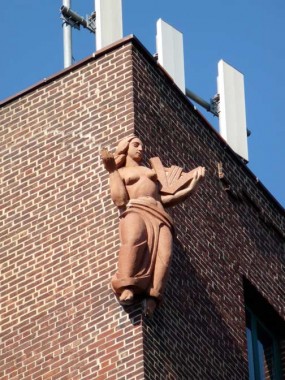

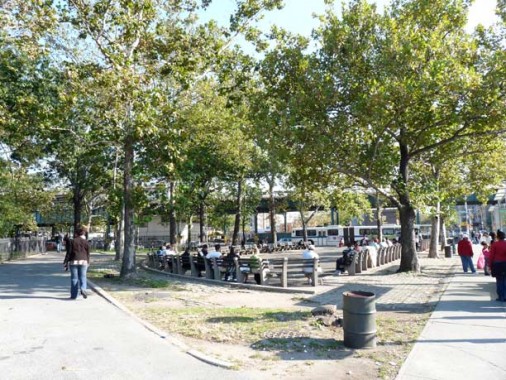

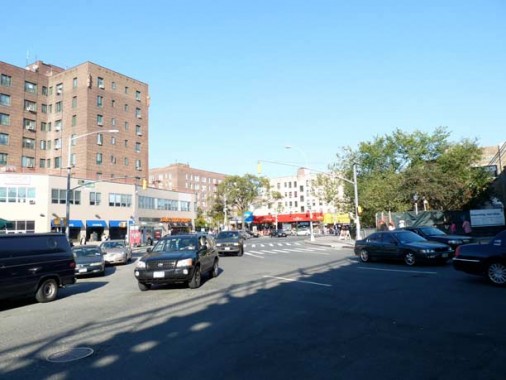

28 comments
The section on the D’Auria – Murphy Triangle was a bit misleading. The Mayor that didn’t show up for the dedication was not Mayor Mitchel. He had been killed in a airplane accident a few months before while training with the Army Air Corp in Louisiana. The missing Mayor would have been Mayor John Hylan, who won the election at the end of 1917.
According to the Parks Department’s web site, Julius Richman Park is officially known as “Richman (Echo) Park”.
It is not the Department of Transportation that honors local heroes like Dion DiMucci with signs. The City Council passes a bill designating a location with a local person’s name, and the Mayor signs the bill into law. DOT just puts up the sign.
I was born & raised in Parkchester. It was a nice place to live but the lack of air conditioning caused me to migrate to Flushing in 1972 after my graduarion from Queens College. It’s amazing to see how the Bronx has actually changed for the better; Physically many of the neighborhoods you visited appear nicer than they did 40 years ago. In 1977 my parents finally fled Parkchester & resettled in Queens, severing our ties with what was then the borough of despair & decay. Looks like time does heal some wounds.
Regarding Time’s appraisal of the Corvair: It wasn’t as bad as Ralph Nader said it was but it was no Porsche, either. I know because I owned a 1965 . It expired after only 2 years in my care (I was the second owner). For more details read my reminiscence which was published in the December 2011 issue of Hemmings Classic Car (“My Beloved Corvair Monza”). Porsche sophoistication at a Chevrolet price wasn’t a realistic concept, but it was fun while it lasted.
Once Parkchester became a condominium the electrical service was upgraded and new windows were installed. After that air conditioning was allowed and even sold through the management office.
We had air conditioning back in the 50s because of special dispensation. The only problems were that units at that time were enormous and because of the window frames the unit had to be entirely in the room. Not very efficient but better than nothing.
What Mark says about the neighborhoods looking better now than they did 40 years ago is mostly true.
My grandmother’s house was (and of course still is) at 1365 White Plains Blvd. just across the street and up past the stores from ‘Virginia Park’. I remember going to this park just after it was built, and I remember it as a plain asphalt area with little stick trees. Good to see the trees have thrived and now offer some shade and character. There used to be typical park swings there in the backside (my primary activity in the park) – did not see them in the pics – are they still there?
Of course Parkchester offered many better equipped parks (better swings, carousels, etc.) as well as Macy’s. Gristedes, Loew’s, and lots of other fun spots. And St. Helena’s (with Msgr. Scanlon swinging his rosary beads and singing loudly but flatly) always kept Sundays busy. Those were the days….
Italian Americans numbah 1 !
The Oscar-winning 1955 film “Marty” shows much of the Belmont neighborhood and how little it has changed. The retail market is shown in the opening credits and a scene takes place on the stairs of Our Lady of Mount Carmel.
Great piece. The railroad is MAINLY used by Amtrak. However, freight trains use this trackage going in/out of Hunts Point during the midnight hours.
Thank you. I grew up here in the 60’s and this was a walk down memory lane
The mural of the Sacred Heart is next to the Albanian flag. There are a large number of first and second generation Albanians living in the Bronx. The early Albanian immigrants were refugees who managed to get out from behind the Iron Curtain in the chaos that followed WWII. They settled in the Bronx mostly because it was cheap. More recent immigrants took advantage of the fall of communism to get out. They where attracted to the Bronx because of the established Albanian community already living there. BTW, Christian Albanians are a minority. Albania is the only country in Europe that is majority Muslim.
As for the Chevy Corvair, it was an early victim of GM cost cutting. The 60-64 models had primitive(cheap) rear suspensions that contributed to dangerously unstable handling. The 65-69 models had improved suspensions, but the damage had been done, and the sales numbers never recovered. They were, however, nicely styled cars.
Lambert Houses are not NYCHA.
Re: the Notre Dame Apartments on 183 Street: As I recall, from the late-1960s, it was then some type of nursing home or residence for seniors at that time. I recall that there was a retired NYC fireman who was a resident there who actually worked in the firehouse across the street on Belmont Ave. (Engine 88), and he would occasionally converse with the on-duty firemen through the fence which faced out on Belmont.
There were, at one time, several pedestrian crossings over the Amtrak tracks along Tremont Ave. They were at least three that I remember: one connecting Tremont at about Beach Ave. to the other side in Van Nest, and one or two down towards past Parkchester, one of which may have been at Paulding Ave (?). The other vehicle crossing is at Williamsbridge Road.
Nice job!
I thought streets were only renamed or co-named for people who are deceased. Does anyone know when this policy was changed. In Brighton Beach, a Parks Department sign was put up on the boardwalk to honor Neil Sedaka because DOT refused to put up a sign for a person who was still living.
I was born in Parkchester, my parents were original tenants, and I lived there for 26 years, eventually moving to have air conditioning and more room. I still go back to Parkchester once a year-I have to-I need to relive my childhood, and I ride around all over the Bronx. I am also on the Monroe alumni committee, which makes the reunions, and my first teaching job was in Columbus HS-great memories of the Bronx are mine.
Love your site an detailed research …wow!! I am A Bronx born ,now Dutchess County resident & architectual history buff. Can you help me find any info on Grote /Grote ave…I have a photo of the Grote Mansion 1923 as Aqainis Hall 182 street & Belmont ave? …I.E.Sparkhill Dominican Sisters’ Home…but who are the Grotes? I’m finiding one in San Fran hitting it big in the late 1800’s-is there anything you can tell me ?? apparently Frederich Grote owned large tracts of Bronx soil>but when and how $$ …I’m a map fan too…would love to trade notes sometime thankyou , keith
Musician Frederick Grote lived in the area in the 1870s. The street partially follows the route of the old Kingsbridge Road.
To whomever compiled this presentation, thank you very much. It brought back early childhood memories, including photos of my old neighborhood, 183rd and Crotona. Yes, the same apt building where Dion grew up. Our dads where friends. I think it’s time to revisit the old neighborhood.
Ran across your website seeking info on Lambert Houses, where my family lived for several years. Thank you for this walk through the old neighborhood. We used to walk all over the Bronx, including as far as Eastchester Road. It would be nice if non-New Yorkers saw all the beauty that is the Bronx. Every neighborhood has something to offer … food, music, culture. Thanks again!
To the team who did all this research, I thank you immensely. If you have any information about 1956 Crotona Parkway, such as the architect who designed it, I’d be most grateful. I’m writing a memoir about the years I lived there: 1948 to 1965. Construction started in 1904 and it was completed in 1910 or 1911, and was named Venice Court. But that’s all I have been able to find. Any help will be much appreciated.
Thanks again, Carolee Philips Kawer
Please see the above note I left in April. I am trying to locate an old photo of the building, when it looked quite lovely, not the way it appears now. Any help will be appreciated.
Thank you.
Carolee Philips-Kawer
Great photos. I enjoyed the ones of St. Joseph’s Church and school as well as the 48th. Precinct on Bathgate Avenue. I was born and raised on E. 180th. st between Park and Washington Avenue. We moved to Yonkers in 1957. I was an altar boy in St. Joseph’s and attended seventh and eighth grade in the grammar school.
Great article. I recently became aware of a person’s website and needed to state that We have truly appreciated exploring ones blog site blogposts. Of course We are signing up for ones rss feed that i’m wanting you’re posting yet again before long! Great article. I recently became aware of a person’s website and needed to state that We have truly appreciated exploring ones blog site blogposts. Of course We are signing up for ones rss feed that i’m wanting you’re posting yet again before long!
What a great walk! I grew up in Parkchester and my family were original tenants. It was a wonderful place for kids but it amazes me the Metropolitan Life could have gotten away with the discrimination policy regarding their rentals. To this day it is a very attractive place.
I was born in Parkchester and also lived on White Plains Rd. We moved in the early 40’s because of the future construction of the Cross Bx Expressway. There was a horse staple behind the two family house we lived in. The horse were used by street vendors. I would guess we lived near or where Virginia Park is now. I wanted to know if anyone has any photos of that area in the early 40’s. I also remember riding my tricycle up White Plains Rd and possibly Wood Street where I visited a sweet smelling candy store.
I grew up in Parkchester during the 50s and 60s. We moved to Connecticut in 1969 just as the Bronx began to go downhill. I loved growing up there and have fond memories of the Good Humor Man pushing his cart around the ballfield, playing tag around the flagpole in the North quadrant, our moms spending warm summer evenings sitting on the benches as we kids played in the dark with no worries for our safety, tons of kids to play with, “calling for” our friends which meant just ringing their doorbell to see if they could come out to play. No playdates back then.
Doing some family history research recently sent me to Street Views and pics of where the Irish side and the immigrant Belgian side of my family lived back in about 1910. Not sure if the one address I found–which is a block of apartments–is original to the block but—obviously NOT in one of the nicer sections of The Bronx! Have seen nicer on the next gen of these families and then they were gone to Jersey; Conn; etc.
Story told in one branch::: The One That Got Away—My grand father on my Irish side decided that his jewelry business–on Radio Row; condemned for the WTC—was doing so well that he could afford to move his growing family to NJ. He moved to a nice house–still there!–in Englewood NJ and wanted the REST of the family to visit. Apparently this move was viewed as a “betrayal” and tho they TOLD him they were coming for the first Thanksgiving there; however; after my Grandmother slaved away all day it became apparent that they were NOT coming—they really never spoke again. Sad that trying to better your family’s surroundings was viewed as a “betrayal” to this extent!
When I grew up in Bergen County NJ in the 60’s-70’s the Bronx was—a wasteland; that was THE scary place; getting lost one night we had to follow a BUS to a route we knew!!!!—Scenes of “Fort Apache” were always in the front of your mind when it was mentioned. I did not know at that time that my family had LIVED there; I would have been horrified!
how’s your sister iris?
Dear Carolee,
I am looking forward to reading “1956 Crotona Parkway”. Powells no longer has the paperback so I will have my husband get the Kindle.,
We lived at 1956 Crotona Parkway from 1961-1965. I have one photo of the entrance to the building – the courtyard – not the whole building however. Just the first 3 storiis. fI worked with animals at the Bronx Zoo and often brought baby animals to our apartment to feed them overnight. The Kangaroo was the cutest. I remember some of the residents but few names. The Super was nice. His wife brought our new baby a beautiful baby dress. –
After our baby was born in 1963 I spent my days walking to Arthur Avenue to buy food – especially the Open Market. I have some photos of a couple of shops along the street. I remember the street festivals by the Catholic Church – the smell of cooking sausage and peppers in the street. World’s best old neighborhood.
Maybe I knew you. I would love to meet you sometime. We live in Portland Oregon now.
Doris Cellarius